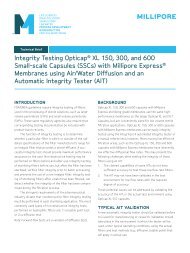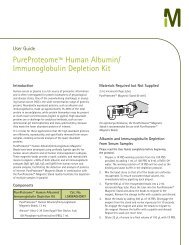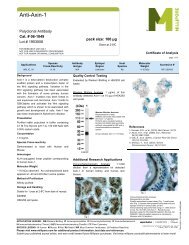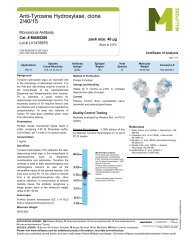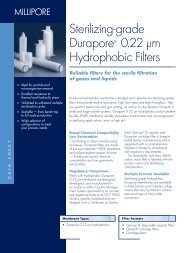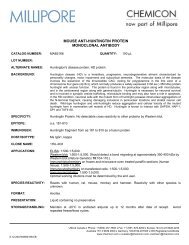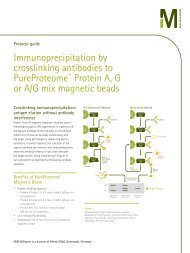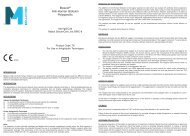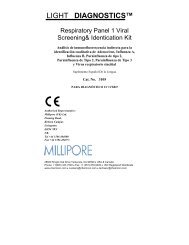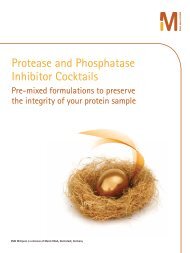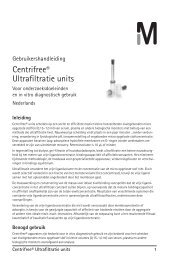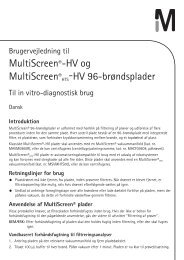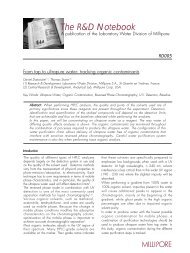Millistak+HC AppGd_textC.qxd - Millipore
Millistak+HC AppGd_textC.qxd - Millipore
Millistak+HC AppGd_textC.qxd - Millipore
You also want an ePaper? Increase the reach of your titles
YUMPU automatically turns print PDFs into web optimized ePapers that Google loves.
How Are Millistak+ HC<br />
Filters Used?<br />
The typical downstream recovery<br />
process for mammalian cell derived<br />
biologics consists of multiple clarification<br />
steps to prepare the liquid-borne<br />
product for either sterile filtration or<br />
direct chromatographic purification.<br />
In the first stage or primary separation<br />
step, the bulk of the cell mass is<br />
removed from the broth—depending<br />
on the volume and type of fermentation<br />
process, different clarification<br />
methods are used, as shown in<br />
Figure 3.<br />
Batch Processing<br />
In large-scale (> 1,000 liter) batch<br />
and fed-batch fermentations, the bulk<br />
of the cell mass is ordinarily separated<br />
by centrifugation or tangential flow<br />
microfiltration. For small batch fermentations<br />
(< 1,000 liter), cartridge depth<br />
filters (NFF) are often used in the pore<br />
size range of 3–5 µm.<br />
Perfused Bioreactor<br />
In contrast to batch processes, perfused<br />
bioreactors are harvested continuously<br />
over extended operating periods<br />
lasting several weeks or months.<br />
For primary clarification, the flowcontrolled<br />
product stream from the<br />
perfusion bioreactor will typically pass<br />
through either a membrane separator<br />
(hollow fiber TFF) or a gravity settler,<br />
with the cell mass recycled to the<br />
fermenter. The crude product is pooled<br />
and then batch-processed for secondary<br />
clarification and final sterile filtration.<br />
A Single Step for Clarification<br />
and Prefiltration<br />
The effluent of these various primary<br />
clarification steps is generally unsuitable<br />
for either sterile filtration or<br />
chromatographic processing. The level<br />
of suspended matter in all cases<br />
(which varies by method) will cause<br />
rapid downstream fouling, with significant<br />
cost impact. The turbidity ranges<br />
noted in the process schematic in<br />
Figure 3 are indicative of the particle<br />
loads present. Even in the case of<br />
TFF microfiltration—typically executed<br />
with a 0.45 – 0.65 µm membrane—<br />
particle loading in the permeate does<br />
not allow for direct sterile filtration at<br />
any reasonable capacity or cost.<br />
Further clarification is required, for<br />
which disposable NFF filters are<br />
normally used (depth or surface types).<br />
The challenge confronting the process<br />
engineer is to arrive at an integrated<br />
clarification and sterile filtration train that<br />
will minimize overall production costs.<br />
In many cases, secondary clarification<br />
of tissue culture fluid involves several<br />
(two or three) serial filtration steps. The<br />
need for multiple separations arises from<br />
the broad range of particle sizes and<br />
Millistak+ HC Filters Application Guide 3



